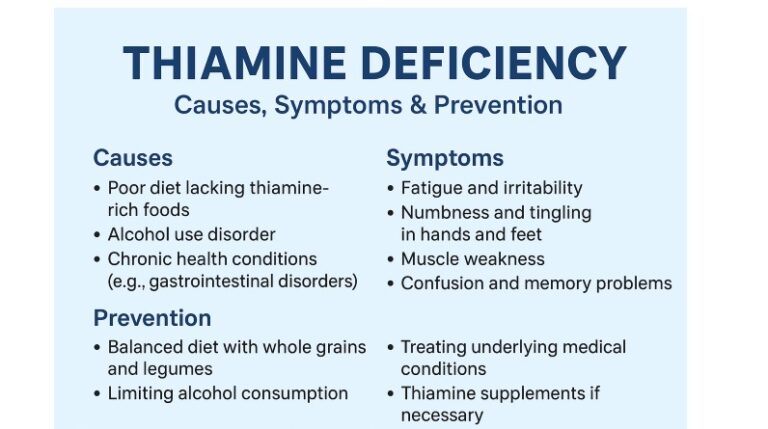Thiamine deficiency—sometimes called vitamin B1 deficiency—remains a silent but serious health issue worldwide. While it is often linked to alcohol misuse or diets based on white rice, new research highlights that the condition is not confined to developing regions or specific populations. From hidden risks in modern eating habits to overlooked hospital practices, thiamine deficiency deserves far more attention than it usually receives.
In this article, we’ll explore causes, symptoms, diagnosis, treatment, prevention strategies, and fresh perspectives that often go unnoticed in standard medical explanations.
What Is Thiamine and Why Is It Essential?
Thiamine (vitamin B1) is a water-soluble vitamin critical for:
- Converting carbohydrates into energy (via glucose metabolism)
- Supporting nerve conduction and brain function
- Ensuring proper heart muscle activity
- Helping with the metabolism of fats and proteins
Because thiamine is not stored in large amounts in the body, deficiencies can develop within 2–3 weeks of inadequate intake, especially in vulnerable groups.
Global and Modern Context of Thiamine Deficiency
Traditionally, thiamine deficiency (beriberi) was linked to populations consuming polished white rice. Today, however, the picture is more complex.
- Global prevalence: A review from The Lancet Global Health estimated that thiamine deficiency affects millions annually, particularly in Southeast Asia and Africa.
- Hidden in developed countries: In Western nations, deficiency frequently occurs in people with alcohol use disorder, chronic illness, or eating disorders.
- Hospital cases: Patients fed intravenously (IV) without added thiamine are at risk of sudden neurological complications such as Wernicke encephalopathy.
This highlights a paradox: even in high-income countries with food abundance, thiamine deficiency persists because of lifestyle and medical oversights.
Causes of Thiamine Deficiency
Thiamine deficiency may result from multiple overlapping factors:
1. Inadequate Intake
- Diets dominated by processed carbohydrates (white flour, sugar, polished rice)
- Eating disorders (e.g., anorexia nervosa)
- Severe food insecurity
2. Alcohol Use Disorder
- Alcohol replaces nutrient-rich foods in the diet
- Alcohol interferes with absorption and storage of thiamine
- Increases the body’s demand for thiamine
3. Increased Physiological Demand
- Pregnancy and breastfeeding
- Hyperthyroidism (overactive thyroid)
- High fever or infection
- Strenuous exercise
4. Malabsorption and Medical Conditions
- Chronic diarrhea
- Crohn’s disease or celiac disease
- Liver disease
5. Rare Genetic Causes
- Inherited disorders affecting thiamine transport or metabolism
Symptoms of Thiamine Deficiency
Early signs are often vague and overlooked. If untreated, deficiency may progress to severe, life-threatening conditions.
Early Symptoms
- Fatigue
- Irritability
- Memory issues
- Loss of appetite
- Weight loss
Advanced Symptoms
| Form of Deficiency | Key Symptoms | Examples |
| Dry Beriberi | Nerve & muscle abnormalities | Pins-and-needles, burning feet, muscle weakness |
| Wet Beriberi | Heart failure & fluid retention | Rapid heartbeat, swollen legs, low blood pressure |
| Wernicke Encephalopathy | Brain dysfunction (often in alcohol misuse) | Confusion, eye movement problems, poor coordination |
| Korsakoff Psychosis | Chronic memory disorder | Forgetting recent events, fabricating memories |
| Infantile Beriberi | Severe in infants of deficient mothers | Sudden heart failure, weak cry, absent reflexes |
Diagnosis of Thiamine Deficiency
There is no single standard blood test widely available to confirm deficiency. Instead, diagnosis often relies on:
- Medical history (diet, alcohol use, risk factors)
- Physical examination (neurological and cardiac assessment)
- Symptom improvement after thiamine supplementation
In hospitals, doctors may also check electrolytes and liver function tests to rule out related complications.
Treatment of Thiamine Deficiency
Treatment is straightforward but time-sensitive.
- Thiamine Supplements
- Oral tablets for mild cases
- IV or intramuscular injections for severe cases
- Multivitamins
- Given because deficiency often coexists with other B vitamin deficiencies
- Lifestyle and Diet Changes
- Reducing or stopping alcohol
- Increasing whole grains, legumes, nuts, pork, and fortified cereals
- Hospital Protocols
- Patients at risk (especially with alcohol misuse) are routinely given thiamine before glucose infusions to prevent Wernicke encephalopathy.
Why Thiamine Deficiency Is Still Overlooked
Despite being easy to prevent and treat, thiamine deficiency often goes undiagnosed. Here’s why:
- Non-specific early symptoms (fatigue, irritability) mimic common issues like stress or anemia.
- Modern diets rich in refined carbs can be calorie-dense but micronutrient-poor.
- Hospital oversights: Thiamine is sometimes missed in IV feeding protocols.
- Alcohol stigma: Patients with alcohol misuse may delay seeking help, worsening brain-related complications.
This suggests that thiamine deficiency is not just a “developing country problem” but also a public health blind spot in modern medicine.
Preventing Thiamine Deficiency
Dietary Sources of Thiamine
- Whole grains and fortified cereals
- Legumes (beans, lentils, peas)
- Nuts and seeds
- Meat (especially pork and liver)
- Potatoes
Practical Tips
- Swap white rice for brown rice or quinoa.
- Include legumes at least 3 times per week.
- If you consume alcohol regularly, consider a daily B-complex supplement.
- Pregnant and breastfeeding women should check vitamin needs with their healthcare provider.
Quick Statistics on Thiamine Deficiency
- Thiamine deficiency can develop in as little as 2–3 weeks of inadequate intake.
- Up to 80% of people with alcohol misuse disorder develop some degree of thiamine deficiency.
- In Asia, where polished rice is common, deficiency rates can reach 30–50% of certain populations.
Key Takeaways
- Thiamine deficiency is both ancient and modern—caused by poverty in some places and lifestyle choices in others.
- Symptoms range from vague fatigue to life-threatening neurological and cardiac complications.
- Prevention is simple: a balanced diet and, for at-risk individuals, supplementation.
- Raising awareness among both the public and healthcare providers is crucial to reduce hidden cases.
Conclusion
Thiamine deficiency is more than a textbook disease. It reflects the intersection of nutrition, lifestyle, and medical care practices. In an age where processed foods dominate and hospital care can sometimes overlook micronutrient needs, thiamine deficiency is a reminder that even small vitamins have a huge impact on health.
By recognizing early signs, addressing risk factors, and promoting balanced diets, we can prevent the devastating effects of this easily correctable condition.
FAQs
- How quickly can thiamine deficiency develop?
Thiamine deficiency can develop in as little as 2–3 weeks of poor intake, especially in people with high metabolic demands or chronic illness. - What are the first warning signs of thiamine deficiency?
Early signs include fatigue, irritability, poor memory, and loss of appetite. These can easily be mistaken for stress or anemia. - Who is most at risk for thiamine deficiency?
People with alcohol use disorder, eating disorders, chronic gastrointestinal problems, or those on IV feeding without supplementation are most at risk. Pregnant and breastfeeding women may also need higher amounts. - Can thiamine deficiency cause permanent damage?
Yes. If untreated, severe thiamine deficiency can lead to Wernicke-Korsakoff syndrome, which causes lasting brain damage and memory problems. - How can I prevent thiamine deficiency through diet?
Include whole grains, legumes, nuts, seeds, pork, and fortified cereals in your diet. Reducing alcohol intake also lowers the risk. - Is thiamine supplementation safe?
Yes, thiamine supplements are safe and well-tolerated. The body excretes excess amounts in urine since it is water-soluble.
For more insightful articles and the latest updates, keep visiting Hacoo.

